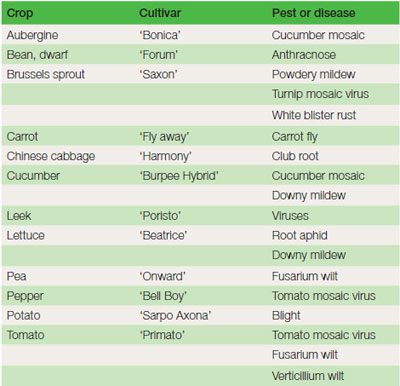Selection for plant resistance
ContentGenetic answers to plant health problems Wild plants show high levels of resistance to most pests and diseases. In the search for high yields and extremes of flower shape and colour, plant breeders have often failed to include this wild plant resistance. However, in crops such as antirrhinum, lettuce and tomatoes, one or more resistance genes have been deliberately incorporated to give protection against rust, downy mildew and tomato mosaic virus respectively. However, the disease organisms competing against the resistance may overcome the genetic barriers and the crop thus again becomes infected. Growers may sow a sequence of cultivars (such as in lettuce), each with different resistance genes, in order that the disease organism (such as downy mildew) is constantly exposed to a new resistance barrier, and thus limit the disease.
Examination of the genetics of wild plant resistance usually shows that there are several (often many) genes contributing to the overall resistance effect. The complex nature of the resistance prevents the frequent development of new strains of diseases that could seriously affect the plant. Gardeners and professional horticulturist alike are increasingly looking to choose cultivars with proven long-term resistance as a feature that is as important to them as yield and plant quality, etc. Recently introduced cultivars of cabbage such as ‘Kalaxy’ are claimed to have stable resistance to club root, while cultivars of potatoes such as ‘Sarpo Axona’ have until now shown very good leaf resistance and very good tuber resistance to potato blight. Looking at plant resistance with a slightly wider view, it should be noted that some strains of fungus are specific to particular families of plant. For example, a Fusarium oxysporum wilt strain attacking tomatoes (member of the Solanaceae family) will not carry over to a subsequently planted crop of pinks and carnations (members of the Caryophyllaceae). Vegetatively propagated species, such as potatoes, and tree crops, such as apple, which remain genetically unaltered for many years are now being bred with high levels of ‘wild plant’ resistance (to blight and powdery mildew respectively on potato and apple) so that the crops may resist these serious problems more permanently. Crop resistance to insects is now being more seriously considered by plant breeders. Some lettuce cultivars are resistant to lettuce root aphid (Pemphigus bursarius). A few carrot cultivars have some resistance to carrot fly (Psila rosae). A new apple cultivar has shown resistance to apple aphids. Table 16.3 illustrates some vegetable cultivars showing their resistance to various diseases and pests. |





